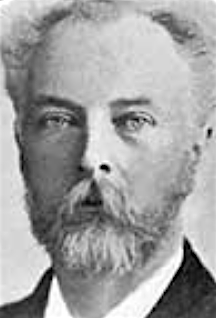
Watson Fothergill was born Fothergill Watson in Mansfield, Nottinghamshire, England on 12 July 1841 and was articled to Frederick Jackson in Nottingham in 1856. He then worked as an assistant to Isaac Charles Gilbert (1822-1885) in Nottingham and to Arthur William Blomfield (1829-1899). Fothergill commenced independent practice as an architect in Nottingham in 1864 and from 1880 was in partnership with Lawrence George Summers (1854-1940).
Fothergill worked almost exclusively in Nottingham where he designed over 100 buildings, including private residences, churches, banks, offices and warehouses, He died in Nottingham on 6 March 1928.
* He changed his name to Watson Fothergill in 1892
Architectural projects by Watson Fothergill: House, Mapperley Road, Nottingham [Fothergill's own house] (1870); 5 & 7 Lenton Road, The Park, Nottingham (1873); Temperance Hall, North Circus Street, Nottingham (1873-76); Nottingham and Nottinghamshire Bank, Church Street, Mansfield, Nottinghamshire (1874-75); Nottingham Daily Express Offices, Printing Works and Shops, Parliament Street, Nottingham (1875): King's Arms, Ratcliffe Gate and Newgate Lane, Mansfield, Nottinghamshire (1875-77); Cattle Market, Nottingham Road, Mansfield, Nottinghamshire (1876-78); Congregational Church, Westgate, Mansfield, Nottinghamshire (1876-78); Nottingham and Nottinghamshire Bank and Residence, Thurland Street, Nottingham (1877-82); house, Crow Hill Drive, Mansfield, Nottinghamshire (1880); Six houses, shops and carriage house, Castle Road and Houndsgate, Nottingham (1882-83); Five houses and Shops, Derby Road, Nottingham (1884); Institute and Coffee Tavern, High Street, Hucknall, Nottinghamshire (1884); Nottingham and Nottinghamshire Bank, Cattle Market, Loughborough, Leicestershire (1885); 405 Mansfield Road, Nottingham (1885); Institute and Coffee Tavern (Budworth Hall), High Street, Ongar, Epping Forest, Essex (1885-87); Walton House, 39 Newcastle Drive, The Park, Nottingham (1886); St. Nicholas' Church Rectory, Castle Gate, Nottingham (1886-87); 409 and 411 Mansfield Road, Nottingham (1886-87); Nottingham and Nottinghamshire Bank, Kirk Gate, Newark on Trent, Nottinghamshire (1885-87); rebuilding of Black Boy Hotel , Long Row, Nottingham (1886-88); 62 and 64 Castle Boulevard, Nottingham (c.1888); 3 and 4 Huntingdon Drive, Nottingham (c.1888); Samuel Smith & Co's Bank, 24 Market Place, Long Eaton, Derbyshire (1889); warehouse (Milbie House), Pilcher Gate, Nottingham (1889); Elberton House, 9 Hardwick Road, Nottingham (1890); Norris Almhouses, Berridge Road, Nottingham (1892-93); Emmanuel Church, Woodborough Road (1883-93; Woodborough Road Baptist Church, Woodborough Road and Alfred Street North, Nottingham (1893-95); Simons and Pickard Paper Warehouse, Lenton Boulevard, Nottingham (1893-94); house, Kingswood, Bulcote, Nottinghamshire (1893); 1 and 3 Sherwood Rise, Nottingham (1894-95) conversion of 15 and 17 George Street, Nottingham into offices for Watson Fothergill (1894-95); Jessops' shop and workrooms, 14–30 King Street, Nottingham (1894-97); four shops and offices, Queens Chambers, Long Row and King Street, Nottingham (1896-99); shop and office for Furley and Co., Parliament Street and Clinton Street, Nottingham (1896-97); extension to Ellenborough House, 3 South Road, The Park, Nottingham (1896-97); warehouses for Cuckson, Hazeldine and Manderfield; Stoney Street and Barker Gate, Nottingham (1897-98); additions to Black Boy Hotel and two shops, Long Row, Nottingham (1897-1900); rebuilding of the Rose of England Inn, Mansfield Road, Nottingham (1898–1900); Brewery, Mar Hill, Carlton, Nottinghamshire (1899); Nottingham and Nottinghamshire Bank and house, 111 Carrington Street, Nottingham (1899); Nottingham and Nottinghamshire Branch Bank, St Ann's Well Road, Nottingham (1900-01); 16 houses, Foxhall Road, Nottingham (1901-02); Union of London and Smith's Bank, Market Place, Bulwell, Nottinghamshire (1904); house, Mapperley Road, Nottingham, with Lawrence George Summers (1905); 4 houses, Mansfield Road and Bingham Road, Nottingham (1906-07).
_____
Other projects by Fothergill are listed in his entry in Who's Who in Architecture 1914. These include Albert Hall, Emmanuel Church of England: Baptist Chapel, Woodborough Road; St. Nicholas' Rectory; Norris Ladies' Homes; " Daily Express offices and printing works; "Black Boy" Hotel, "Rose of England" Hotel, Queen's Chambers, Market Place; Jessop's drapery establishment, monument to Bonington the painter, Waverley Street — all in Nottingham; Nottingham and Notts banks in Thurland Street, Carrington Street, and St. Ann's Well Road: numerous buildings in Newark, Mansfield, Retford, Loughboro', and in the neighbourhood of London.
Avery, Derek. Victorian and Edwardian Architecture. London: Chaucer Press, 2003
Brand, Ken. Watson Fothergill: Architect. Nottingham: Nottingham Civic Society, 2nd edition, 1987
Brand, Ken. ‘Watson Fothergill: a provincial goth’ in Powerhouses of Provincial Architecture, 1837–1914, edited by Kathryn Ferry. London: Victorian Society pp. 28–43
Directory of British Architects 1834-1914. Compiled by Antonia Brodie, et al. Volume 1: A-K. London; New York: British Architectural Library, Royal Institute of British Architects/Continuum, 2001
Fothergill : a catalogue of the works of Watson Fothergill, architect. Compiled by Darren Turner. London: Blurb, 2012
Kilner, Denis S. Watson Fothergill: a Victorian Architect. Ph.D. thesis, University of Nottingham, 1978
Who's Who in Architecture 1914. London: Technical Journals Ltd., 1914